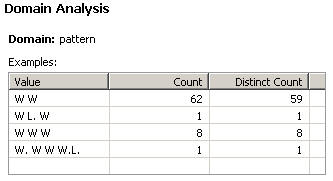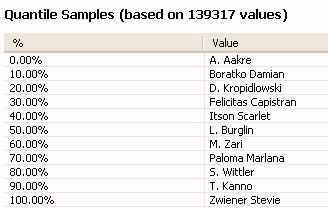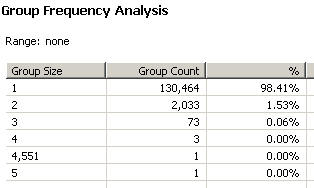The Basic tab provides simple statistics about the data that has been profiled and shows a chart of duplicate and distinct data as a percentage of the whole, as shown in the following image.

The Counts table lists the following values:
- Null. Includes all data that is empty or has a value of null.
-
Non-null. Includes all data that is not empty or does
not have a value of null. This data is divided into two categories,
duplicate and distinct.
- Duplicate. Specifies the number of values that are the same as other values in the list.
-
Distinct. Specifies the number of non-null values that
are different from each other. This data is divided into two categories,
non-unique, and unique.
- Non-unique. Specifies the number of values that have at least one duplicate in the list.
- Unique. Specifies the number of values that have no duplicates.
To understand the meaning of these values, consider the data in the following table.
|
Record No. |
Value |
|---|---|
|
1 |
John Smith |
|
2 |
John Smith |
|
3 |
Rebecca Davis |
|
4 |
Paul Adams |
|
5 |
The Counts table for this data is represented in the following table.
|
Type |
Count |
Record |
Description |
|---|---|---|---|
|
Null |
1 |
Record 5 |
The last record is empty. |
|
Non-null |
4 |
Records 1-4 |
The first 4 records contain data. |
|
Duplicate |
1 |
Record 2 |
There is one duplicate of the John Smith record. |
|
Distinct |
3 |
Records 1, 3, 4 |
There are 3 non-null values that are different from each other. |
|
Non-unique |
1 |
Record 1 |
John Smith has a duplicate record. Therefore, it is not unique. |
|
Unique |
2 |
Records 3 and 4 |
Rebecca Davis and Paul Adams appear only once in the list; they have no duplicates. |




